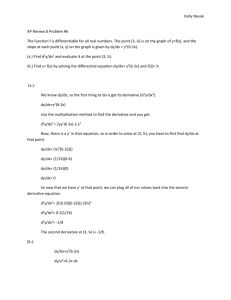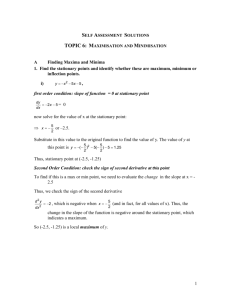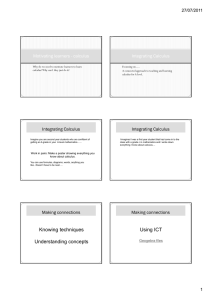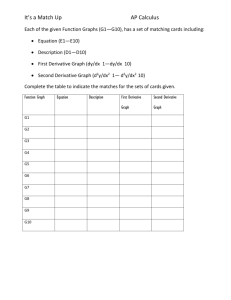Y= f (X) = a + bX
advertisement
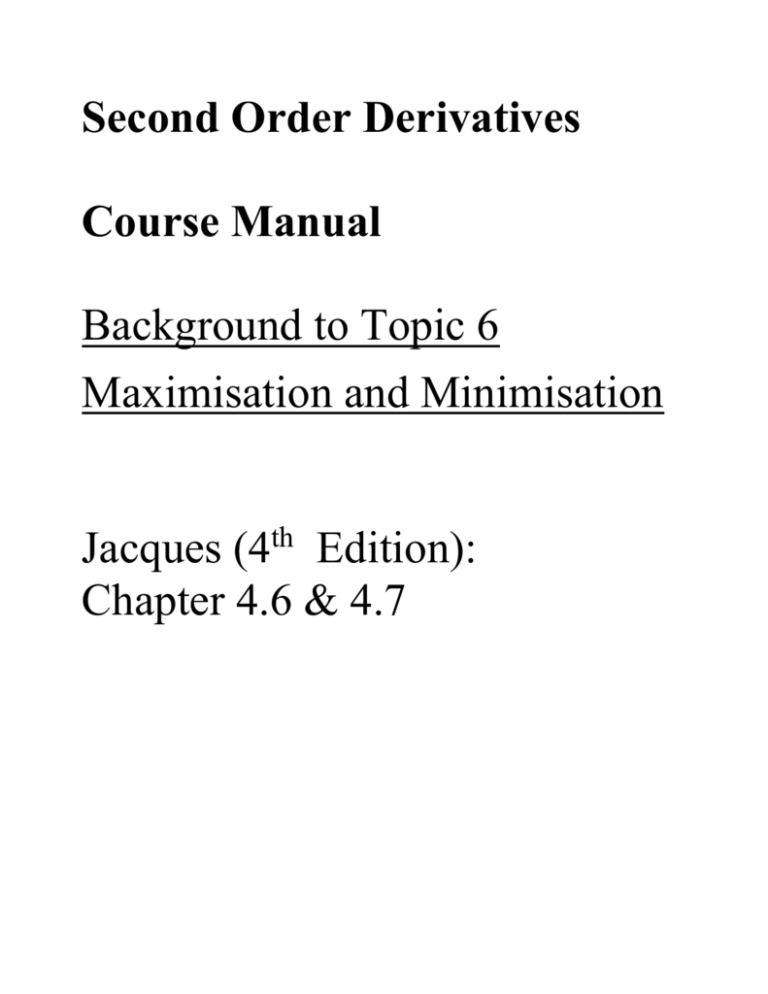
Second Order Derivatives Course Manual Background to Topic 6 Maximisation and Minimisation Jacques (4th Edition): Chapter 4.6 & 4.7 Y Y=a+bX a X Y= f (X) = a + bX First Derivative dY/dX = f = b constant slope b Second Derivative d2Y/dX2 = f = 0 constant rate of change - the change in the slope is zero Y=X >1 Y X Y=X >0 and <1 Y X Y= f (X) = X First Derivative dY/dX = f = X-1 > 0 Positive Slope: change in Y due to change X is Positive Second Derivative d2Y/dX2 = f = (-1) X(-1)-1 or d2Y/dX2 = (-1)(Y/X2) d2Y/dX2 = f = 0 if = 1 constant rate of change d2Y/dX2 = f > 0 if > 1 increasing rate of change (change Y due to change X is bigger at higher X – the change in the slope is positive) d2Y/dX2 = f < 0 if < 1 decreasing rate of change (change Y due to change X is smaller at higher X – the change in the slope is negative) Maximisation and Minimisation •Stationary Points •Second-order derivatives •Applications B Y Max A Min X*=1 X*=4 X Stationary points are the turning points or critical points of a function Slope of tangent to curve is zero at stationary points, f (X) = 0 Are these a Max or Min point of the function? 1) examine slope in region near the stationary point Sign of first derivative around a turning point: Before At After Maximum plus zero minus Minimum minus zero plus /dX = f (X) is (–, 0, +) min dY /dX = f (X) is (+, 0, -) max dY 2) or calculate the second derivative…… look at the change in the slope beyond the stationary point if d2Y/dX2 = f (X) > 0 a minimum the change in the slope is positive beyond the stationary point, so the point is a local minimum if d2Y/dX2 = f (X) < 0 a maximum the change in the slope is negative beyond the stationary point, so the point is a local maximum if d2Y/dX2 = f (X) = 0 indeterminate the change in the slope is zero beyond the stationary point - could be a max, or a min, or an inflection point e.g. inflection point Y f =0 & f =0 X To find the Max or Min of a function Y= f(X) 1) First Order Condition (F.O.C.): set slope dY/dX = f (X) = 0 this identifies the stationary point(s) 2) Second Order Condition (S.O.C.): check the sign of the second derivative (gives the change in the slope) d2Y/dX2 = f (X) > 0 a minimum d2Y/dX2 = f (X) < 0 a maximum d2Y/dX2 = f (X) = 0 indeterminate this identifies whether the slope of the function is increasing, decreasing, or does not change after the stationary point(s) Find the Maxima and Minima of the following functions: 2 (i) y x 2 x 1 F.O.C. : slope=0 at stationary point dy 2x 2 0 dx 2 x 2 x 1 S.O.C. : check sign of second derivative at x=-1 d2y 2 0 (slope increases after the stationary point, so must 2 dx be a minimum at x= -1) 30 25 Y 20 15 10 5 0 -4 -3 -2 -1 0 X 1 2 3 4 Example: A firm faces the demand curve P=8-0.5Q 3 1 and total cost function TC= /3Q 2 3Q +12Q. Find the level of Q that maximises total profit and verify that this value of Q is where MC=MR Solution: P = 8 - 0.5Q inverse demand function TR (Q) = P.Q = 8Q - ½Q2 TC (Q) = 1/3Q3 - 3Q2 + 12Q MAX (Q) = TR (Q) - TC (Q) (Q) = -4Q + 2 ½ Q2 – 1/3Q3 MAX (Q) = -4Q + 2 ½ Q2 – 1/3Q3 First Order Condition: d/dQ = f (Q)= - 4 + 5Q – Q2 = 0 (solve quadratic – Q + 5Q – 4 by applying formula: Q b 2 b 2 4ac 2a ) Optimal Q solves as: Q*=1 and Q*= 4 Second Order Condition: d2/dQ2 = f (Q) = 5 – 2Q Sign ? f = 3 > 0 if Q*= 1 (Min) f = - 3 < 0 if Q*= 4 (Max) So profit is max at output Q = 4 TR (Q) = 8Q - ½Q2 dTR MR 8Q dQ Q = 4 then MR = 4 TC (Q) = 1/3Q3 - 3Q2 + 12Q MC = dTC Q 2 6Q 12 dQ Q = 4 then MC = 16 – 24 +12 = +4 At Q = 4, MR = MC Maximisation and Minimisation Tax Example Jacques (4th Edition): Chapter 4.6 Supply and Demand Equations of a good are given, respectively, as P- t = 8 + QS P = 80 – 3QD A tax t per unit, imposed on suppliers, is being considered. At what value of t does the government maximise tax revenue in market equilibrium? Set Supply equal to Demand In equilibrium, QD = QS Q + 8 + t = 80 – 3Q Solve for Q Qe = 18 – ¼ t Tax Rev. T = t.Qe = t(18 – ¼ t) MAX T(t) = 18t – ¼ t2 t* First Order Condition for max: dT/dt = 18 – ½ t = 0 t* = 36 Second Order Condition for max: d2T/dt2 = -½ < 0 (Max) Results t* = 36 Qe = 18 – ¼ t* = 9 T = t*.Qe = 18t* – ¼ t*2 = 324 Pe = Qe + 8 + t*= 53 If t = 0, then Qe = 18 Pe = Qe + 8 = 26 Is the full burden of the tax passed on to consumers? Ex-ante (no tax) Pe = 26 Ex-post (t* =36) Pe = 53 Yet the tax is t*= 36 but the price increase is only 27 (75% paid by consumer) Another Example…Manual, Section 5, Q 6 Cost Producing Q units output given C 8K 2 2 Q K capital K: (a) if K=20 in Short Run, find the level of Q at which AC is minimised. Show that MC and AC are equal at this point. C = (8*20) + (2/20)Q2 = 160 + 0.1Q2 AC = C/Q = 160/Q + 0.1Q and MC = dC/dQ = 0.2Q First Order Condition: AC is at min when dAC/dQ = 0 slope AC: dAC/dQ = - 160/Q2 + 0.1 = 0 Q2 = 1600 Q = 40 Second Order Condition: d2AC/dQ2 >0 min. d2AC/dQ2 = + 320/Q3 at Q = 40, d2AC/dQ2 = 320 / 403 >0 min AC at Q = 40 AC at Q=40: 160/40 + (0.1*40) = 8 and MC at Q = 40: 0.2*40 = 8 MC = AC at min AC when Q=40 b) In Long Run, K changes. What level of K minimises costs when Q = 1000? C 8K 2 2 Q K dC/dK = 8 – (2Q2 / K2) = 0 F.O.C. 8K2 = 2Q2 K2 = ¼ Q2 optimal K = ¼Q2 = ½ Q if Q = 1000, optimal K = 500 if Q = Q0, optimal K = Q0/2 min cost producing Q0 = Q0 8 2 2 .Q02 Q0 2 = 4Q0 + 4Q0 = 8Q0 Questions Covered: Section 6: Maximisation and Minimisation Q1: Identifying the max and min of various functions Q2: Identifying the max and min of various functions – sketch graphs Q3: Finding value of t that maximises tax revenues, given D and S functions (as in lecture example) Q4: Similar to Q3 above, but where Qd = a – bP and Qs = c + dP and find impact of t on sales and value of t that maximises tax revenue Q5: Showing that max of total revenue curve occurs where elasticity of demand is unity. Q6: Identifying AC min output level for a given K. And min Costs given optimal K. (lecture example). Q7: (a) Identifying all local max and min of various functions. (b) Identifying profit max output level. Q8: (a) Differentiate various functions. (b) more on finding t that maximises tax revenue
